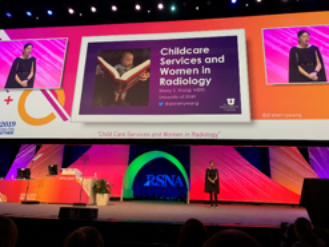Fast Five presentations are a unique look at current radiology challenges
At the 3rd annual Fast Five presentation, Dr. Richard E Heller III introduced five speakers chosen from more than 50 submissions from around the world – a record number of candidates. Each of the innovative, non-clinical topics reflected this year’s theme of “See possibilities together” and were selected by popular vote.

Dr. Sherry S. Wang from the University of Utah presented
“Child Care Services and Women in Radiology.”
Dr. Teresa Martin-Carreras from the Hospital of the University of Pennsylvania presented “Patient-Centered Care and Radiology Reports”. Although patients now have access to their medical information through online portals, “Access doesn’t equal understanding,” said Dr. Martin-Carreras. She focused on bridging the gap of understanding with a health literacy tool called PORTER, which helps patients better understand their radiology reports and improve their overall health literacy.
Dr. Samir J. Parikh from Henry Ford Allegiance Health in Jackson, MS, presented a new paradigm for preventing and treating smoking-related lung cancer in his presentation, “Patient Counseling in the Lung Cancer Clinic”. In his clinic, he and his team put the “patient at the center of care, with the radiologist in the front seat.” He established a patient-centered lung cancer CT screening program that utilizes low-dose CT, along with a smoking cessation counselor, to address lung cancer detection, treatment and prevention. His program has screened about 2,800 patients and found 75 cancers, many of them detected in early stages for improved outcomes.
Dr. Reto Sutter from Balgrist University Hospital in Zurich, Switzerland, proposed three visual techniques to make it easier to communicate clinical studies in “Master the Next Level of Science Communication”. He said visual representations are a perfect fit for radiologists because, “Images are our thing.” His first recommendation was to choose a key image from the study with a short description and a link to the full study, which makes it easy to share on social media. His second recommendation was to create an infographic, an explanatory visual that creates a storyline about the study and its key findings. His third suggestion was to create a #VisualAbstract, or a summary of the study on a single slide that highlights the title of the study, the author and journal where it appeared, and the most important information in icons or images.
Dr. Michael H. Lev from Massachusetts General Hospital in Boston explored mental health and social identity in “How Does Imaging Help Us to Understand What it Means to Be Human?” He said neuro imaging can help determine the impact of medication and talk therapy on patients with mental health concerns like depression – and help clinicians choose which path might be more beneficial for each patient. He also discussed the role of mindfulness and meditation to neuroplasticity (and a better golf game), as well as the potential for AI to be used as a tool for augmented human intelligence in the future.
Dr. Sherry S. Wang from the University of Utah tackled the role of child care for women in radiology with her presentation, “Child Care Services and Women in Radiology”. She delved into the “motherhood penalty” that appears to play a role in the lack of women in leadership positions within radiology, and pinpointed the absence of accessible and affordable childcare options as a major contributor to this trend. She posited that a shift from gender equality to gender equity, which recognizes the needs and constraints of the different genders, will help remove roadblocks and support women in achieving leadership roles. “Being a good mother and a good radiologist shouldn’t be mutually exclusive,” she said.
You can follow the Fast Five conversation on Twitter with #RSNAFast5